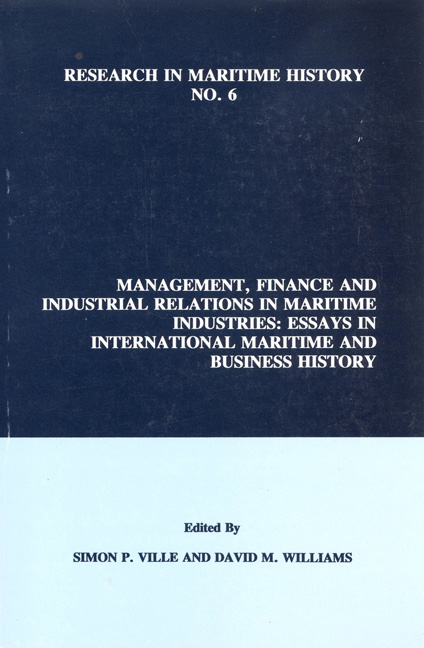 Management, Finance and Industrial Relations in Maritime Industries
Management, Finance and Industrial Relations in Maritime Industries Book contents
- Frontmatter
- Contents
- Contributors
- Introduction
- Contributors
- “Economic Theory, Information and Management in Shipbroking: Fearnley and Eger as a Case Study, 1869-1972”
- “The Early Nineteenth-Century Port of London: Management and Labour in Three Dock Companies, 1800-1825”
- “Owners and Masters: Management and Managerial Skills in the Finnish Ocean-Going Merchant Fleet, c. 1840-1880”
- “Management, Profitability and Finance in Twentieth-Century Spanish Merchant Shipping: The Compañía Maritima Del Nervion as a Case Study, 1899-1986”
- “Twentieth-Century Shipping Strategies: Broström and Transatlantic, Gothenburg's Leading Shipping Companies”
- “Contractors' Bounties or Due Consideration?: Evidence on the Commercial Nature of The Royal Mail Steam Packet Company's Mail Contracts, 1842-1905”
- “Patterns of Ownership and Finance in the Greek Deep-Sea Steamship Fleet, 1880-1914”
- “Financial Weakness and Industrial Conflict in Italian Shipbuilding Between the Two World Wars”
- “Responding to the Global Market in Boom and Recession: Japanese Shipping and Shipbuilding Industries, 1945- 1980
“Shipping and Trade of Chinese Junks in Southeast Asia, 1730-1830: A Survey”
from Contributors
- Frontmatter
- Contents
- Contributors
- Introduction
- Contributors
- “Economic Theory, Information and Management in Shipbroking: Fearnley and Eger as a Case Study, 1869-1972”
- “The Early Nineteenth-Century Port of London: Management and Labour in Three Dock Companies, 1800-1825”
- “Owners and Masters: Management and Managerial Skills in the Finnish Ocean-Going Merchant Fleet, c. 1840-1880”
- “Management, Profitability and Finance in Twentieth-Century Spanish Merchant Shipping: The Compañía Maritima Del Nervion as a Case Study, 1899-1986”
- “Twentieth-Century Shipping Strategies: Broström and Transatlantic, Gothenburg's Leading Shipping Companies”
- “Contractors' Bounties or Due Consideration?: Evidence on the Commercial Nature of The Royal Mail Steam Packet Company's Mail Contracts, 1842-1905”
- “Patterns of Ownership and Finance in the Greek Deep-Sea Steamship Fleet, 1880-1914”
- “Financial Weakness and Industrial Conflict in Italian Shipbuilding Between the Two World Wars”
- “Responding to the Global Market in Boom and Recession: Japanese Shipping and Shipbuilding Industries, 1945- 1980
Summary
The junks that plied Southeast Asian waters between 1730 and 1830 can be divided into two Chinese and Siamese/Cochin-Chinese groups. This paper focuses primarily on Chinese junks and examines ownership, organisation, numbers, size, cost, manning, trade routes, goods and customs controls.
During the Ch'ing dynasty, Chinese nationals were allowed to trade abroad, except in 1661-1683 and 1717-1726. From 1727 to 1735, during the Yung-cheng Emperor's rule, only twenty to thirty junks per year sailed from Kwangtung and Fukien. But from 1735, when Emperor Ch'ien-lung's reign began, the trade began to flourish. As early as 1742, the numbers had risen to about 100. The apex of Chinese junk shipping to Southeast Asia was in the 1780s and 1790s. Thereafter, according to official Chinese sources, the numbers trading to Southeast Asia began to decline (although Western sources do not confirm this).
Ownership and Organisation in Chinese Shipping
Junk owners were usually from Kwangtung and Fukien, two provinces on China's southeast coast. In Fukien, the prefectures of Chang-chou and Ch'uan-chou were famous for sea-going junks. Their counterpart in Kwangtung was Ch'eng-hai County in Ch'ao-chou prefecture. Junk ownership was more important in Fukien than Kwangtung, for the Fukienese had long traditions of seafaring. Patterns of ownership varied. Individuals might sometimes own a junk outright, but more frequently several persons would pool their money. Moreover, owners might invest concurrently in a number of junks, prudent practice since the absence of marine insurance meant that owners had to assume high risks and investment in a number of craft clearly spread those perils. Precisely whom the owners were is often difficult to ascertain. Chinese documents as a rule state only that they were “well-to-do civilians of Chang-chou and Ch'uan-chou,” without giving further details. Who the “well-to-do” were must therefore be a matter of conjecture, but from what is known of Fukien and Kwangtung, capital is likely to have been drawn from landed gentry or officials or, alternatively, from other commercial sectors, such as the salt monopoly or trade-related businesses. Such suppositions are bolstered by the fact that in a traditional society like Ch'ing China, government service and commerce were the only ways to amass fortunes.
- Type
- Chapter
- Information
- Management, Finance and Industrial Relations in Maritime IndustriesEssays in International Maritime and Business History, pp. 203 - 214Publisher: Liverpool University PressPrint publication year: 1994


